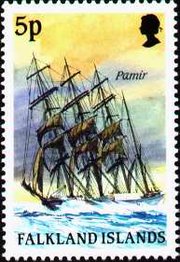Pamir (ship)
|
|
The Pamir was one of the Flying P-Liners, the famous sailing ships of the German shipping company F. Laeisz.
The four-masted barque had a steel hull and was built on the Blohm & Voss shipyards in Hamburg, where she was launched on July 29, 1905. She had an overall length of 114.5 m (375 ft), a beam of about 14 m (46 ft) and a draught of 7.25 m (23.5 ft). Her three fore masts stood 51.2 m (168 ft) above deck and the main yard was some 28 m (92 ft) wide. She had a tonnage of 3020 GRT (2777 net). She carried a total of some 3800 m² (40900 ft²) of sails and could reach a top speed of 16 knots (30 km/h). Her regular cruise speed was around 13 knots.
The Pamir was the third of eight sister ships. She was commissioned on October 18, 1905 and used by the Laeisz company in the South American nitrate trade. Until 1914 she made 8 cruises to Chile, taking between 64 and about 70 days for a one-way trip from Hamburg to Valparaíso or Iquique, the foremost Chilean nitrate ports of the time. During World War I, she stayed in port on the Canary Islands, and was handed over to Italy as war reparation in 1920. In 1924, the F. Laeisz company bought her back for a price of £ 7000 and put her into service in the nitrate trade again.
In 1931, Laeisz sold her to the Finnish shipping company of Gustav Erikson who used her in the Australian wheat trade.
In World War II, the Pamir was seized as a war prize by New Zealand on August 3, 1941, while the ship was in port in Wellington. Subsequently, she made 10 commercial trips between New Zealand and San Francisco and embarked 1947 - 1948 on a trip around the world.
In 1948, she was returned to Erikson and made one last voyage to Australia. On her journey to Finland, she was the last commercial sailing ship to round Cape Horn in 1949.
In 1950, the ship was about to be scrapped, but was saved from that fate by a German shipowner who bought her and her sister ship, the Passat. She was modernized, retrofitted with an auxiliary engine and used as a cargo and sail-training ship on the route to Argentina.
In 1954, the ships were bought by a German consortium. They still made five voyages, but since they were not profitable anymore, they were to be decommissioned after their last voyage in 1957.
The last voyage
On August 10, 1957, the Pamir set sail from Buenos Aires bound for Hamburg. She carried a crew of 86, 52 of which were cadets. The cargo of 3780 tons of barley was almost all stored loose in the holds and ballast tanks. Only 255 tons was stored in sacks, placed on top of the loose grain to hold it in place. On September 21, 1957, she got caught in the hurricane "Carrie" and soon was listing severely to port because the loose grain in her cargo had shifted. She was able to send distress signals before she capsized at 13:03 local time and sank within thirty minutes in the middle of the Atlantic.
The search for survivors lasted for nine days and was organized from the U.S. Coast Guard cutter Absecon. However, only 6 crewmen, of which two were cadets, were rescued alive. The shipwreck was perceived as a tragedy around the world and got extensive press coverage.
External links
- Pamir Memorial (http://pamir.chez.tiscali.fr/Indexm.htm#English), an excellent web site in German, French, and English, with lots of images.
- Chronology (http://sailing-ships.oktett.net/22.html)
- The Pamir in New Zealand (http://freepages.genealogy.rootsweb.com/~ourstuff/PAMIR-TheNewZealandEpisode.htm)
- A Chilenean report (http://www.caphorniers.cl/Pamir/Pamir.htm) (in English).
References
Parrott, Daniel. (2003). Tall Ships Down - the last voyages of the Pamir, Albatross, Marques, Pride of Baltimore and the Maria Asumpta. McGraw Hill. ISBN 0-07-139092-8.de:Pamir (Schiff)

